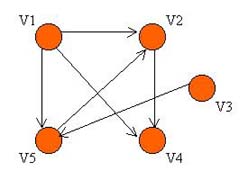 |
|
There are several different ways to represent a graph in a computer. Although graphs are usually shown diagrammatically, this is only possible when the number of vertices and edges is reasonably small.
Graphs can also be represented in the form of matrices.
The major advantage of matrix representation is that the calculation of
paths and cycles can easily be performed using well known operations of
matrices. However, the disadvantage is that this form of representation
takes away from the visual aspect of graphs. It would be difficult
to illustrate in a matrix, properties that are easily illustrated graphically.
Example: Matrix representation of a graph
Consider the following directed graph G (in which the vertices are ordered as v1, v2, v3, v4, and v5), and its equivalent adjacency matrix representation on the right:
 |
|
As you can see from the above graph, if a path of length 1 exists from one vertex to another (ie. the two vertices are adjacent), there must be an entry of 1 in the corresponding position in the matrix. For example, from the vertex v1, we can reach vertices v2, v4, and v5. Therefore, we have a corresponding entry of 1 in the matrix in the first row and the second, fourth and fifth columns.
In general, the number of 1's in the ith row, corresponds
to the number of edges leaving the vertex vi, and the number
of 1's in the jth column, corresponds to the number of edges entering the
vertex vj.
Definition of an Adjacency Matrix
An adjacency matrix is defined as follows:
Let G be a graph with "n" vertices that are assumed to be ordered from
v1 to vn.
The n x n matrix A, in which
aij=
1 if there exists a path from
vi to vj
aij = 0 otherwise
is called an adjacency matrix.
Calculating A Path Between Vertices
As shown in the previous example, the existence of an edge between two vertices vi and vj is shown by an entry of 1 in the ith row and jth column of the adjacency matrix. This entry represents a path of length 1 from vi to vj.
To compute a path of length 2, the matrix of length 1 must
be multiplied by itself, and the product matrix is the matrix representation
of path of length 2.
Example: Computing A Matrix Representation of Path of Length 2
Using the matrix from the previous example and multiplying
it by itself, we obtain the following new matrix:
Original Graph G: |
Matrix representation of path of length 2
|
The above matrix indicates that we can go from vertex v1 to vertex v2, or from vertex v1 to vertex v4 in two moves. In fact, if we examine the graph, we can see that this can be done by going through vertex v5 and through vertex v2 respectively. We can also reach vertex v2 from v3, and vertex v4 from v5, all in two moves.
In general, to generate the matrix of path of length n, take the matrix of path of length n-1, and multiply it with the matrix of path of length 1.
Click here to see how matrix multiplication is done.
Click here to see an interactive
example of an Adjacency Matrix.
Or move on to the next page to go directly to the next section.
|
Back to Terminology: Paths, Reachability, Connectedness |
On to Graph Representation: Adjacency Lists |